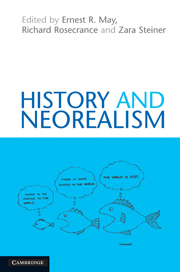Book contents
- Frontmatter
- Contents
- List of tables
- Notes on contributors
- Acknowledgments
- 1 Theory and international history
- 2 Transformations in power
- 3 Domestically driven deviations: internal regimes, leaders, and realism's power line
- 4 How international institutions affect outcomes
- 5 Not even for the seventeenth and eighteenth centuries: power and order in the early modern era
- 6 Austria-Hungary and the coming of the First World War
- 7 British decisions for peace and war 1938–1939: the rise and fall of realism
- 8 Realism and risk in 1938: German foreign policy and the Munich Crisis
- 9 Domestic politics, interservice impasse, and Japan's decisions for war
- 10 Military audacity: Mao Zedong, Liu Shaoqi, and China's adventure in Korea
- 11 The United States' underuse of military power
- 12 The overuse of American power
- 13 Redrawing the Soviet power line: Gorbachev and the end of the Cold War
- 14 Shared sovereignty in the European Union: Germany's economic governance
- 15 John Mearsheimer's “elementary geometry of power”: Euclidean moment or an intellectual blind alley?
- 16 History and neorealism reconsidered
- Index
- References
9 - Domestic politics, interservice impasse, and Japan's decisions for war
Published online by Cambridge University Press: 05 June 2012
- Frontmatter
- Contents
- List of tables
- Notes on contributors
- Acknowledgments
- 1 Theory and international history
- 2 Transformations in power
- 3 Domestically driven deviations: internal regimes, leaders, and realism's power line
- 4 How international institutions affect outcomes
- 5 Not even for the seventeenth and eighteenth centuries: power and order in the early modern era
- 6 Austria-Hungary and the coming of the First World War
- 7 British decisions for peace and war 1938–1939: the rise and fall of realism
- 8 Realism and risk in 1938: German foreign policy and the Munich Crisis
- 9 Domestic politics, interservice impasse, and Japan's decisions for war
- 10 Military audacity: Mao Zedong, Liu Shaoqi, and China's adventure in Korea
- 11 The United States' underuse of military power
- 12 The overuse of American power
- 13 Redrawing the Soviet power line: Gorbachev and the end of the Cold War
- 14 Shared sovereignty in the European Union: Germany's economic governance
- 15 John Mearsheimer's “elementary geometry of power”: Euclidean moment or an intellectual blind alley?
- 16 History and neorealism reconsidered
- Index
- References
Summary
If the quintessential test for a state is to have its managers identify perfectly with it and with perfect rationality identify its interests, few states have been universally well-served. The fault is hardly with those managers. The interests of the state are seldom self-evident and nearly always subject to debate. Even in absolute monarchies or dictatorships, the sovereign's advisers offer competing policies.
Imperial Japan legally was such an absolute monarchy, with its emperor granted nearly unlimited power, in theory. More, the leaders of Japan's Meiji Restoration had a near tabula rasa on which to design a new state, one that would benefit from their intense study of the West and its institutions. Keenly aware of the West's threat, these leaders – inspired, dedicated, and intelligent all – deliberately set out to build a rational state capable of dealing with that threat. They failed spectacularly.
In reality, Japan was not an absolute monarchy. It was a virtually headless state from 1868 to 1945. For its first forty-five years, a measure of consensus was provided by the commitment of its founding generation to the avoidance of sharp internal disputes. Japan could ill-afford these, menaced by the West as it was. But the construction of that consensus required the construction of a governing apparatus that, ironically, acted to make consensus impossible once the founding generation passed away. In its place arose a structure of autonomous and highly competitive ministries – bureaucracies – that created professional and powerful allegiances to themselves.
- Type
- Chapter
- Information
- History and Neorealism , pp. 185 - 200Publisher: Cambridge University PressPrint publication year: 2010

